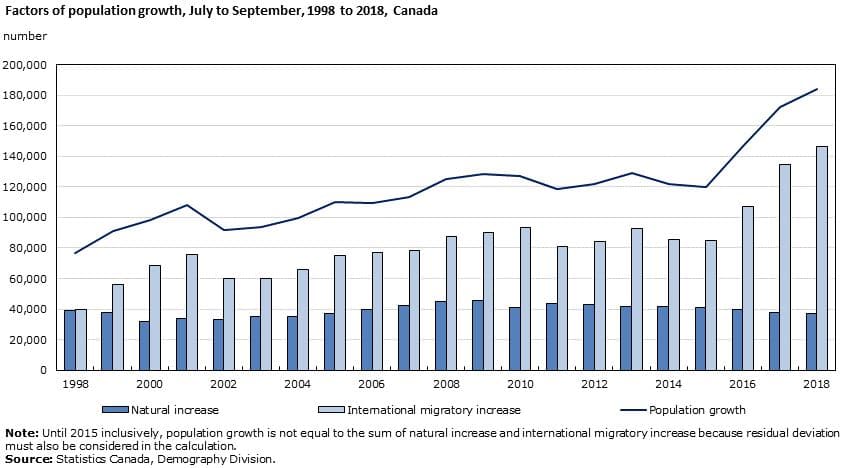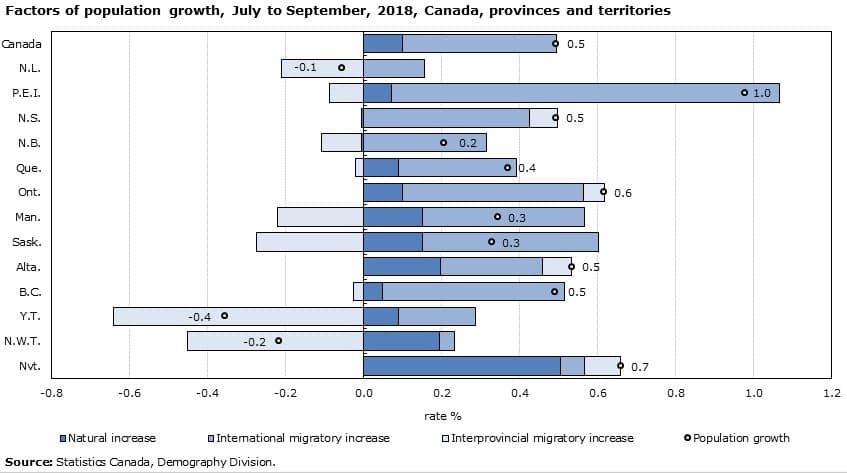International migration to Canada reached record level in third quarter of 2018
International migration to Canada reached an unprecedented level between July 1 and October 1, 2018, and helped the Canadian population grow at a record three-month pace.
Preliminary estimates show Canada's population increased by 183,715 people during the third quarter of 2018. Statistics Canada says this was the largest quarterly increase in absolute numbers since the introduction of its current demographic accounting system in 1971.
International migration alone accounted for most of the increase, with 146,531 people arriving in Canada between July 1 and October 1.
This was the greatest international migratory increase recorded and was attributed to strong immigration levels and the arrival of an unprecedented number of non-permanent residents.

Of the new arrivals, 82,316 were permanent residents and 79,417 were non-permanent residents, which Statistics Canada said were mostly work and study permit study holders. The number of new permanent residents who arrived between July 1 and October 1 was the fifth-largest in a single quarter since the study began in 1971.
Find out if you are eligible for any Canadian immigration programs.
Canada's natural population increase (births minus deaths) in the third quarter was estimated at 37,184. Statistics Canada put the number of births in the third quarter at 103,199 and the number of deaths at 66,015.
"Natural increase in the third quarter has been on a downward trend since the third quarter of 2012," Statistics Canada reported, noting this trend is expected to continue as a result of population ageing.
PEI leads provinces in population growth
International migration drove population growth in nine Canadian provinces between July 1 and October 1, Statistics Canada reported.
The Atlantic Canada province of Prince Edward Island — Canada's smallest province — experienced the highest population growth in the quarter, posting an increase of one per cent.

PEI has undertaken intensive efforts in recent years to attract skilled immigrants through its Provincial Nominee Program to address population decline resulting from an ageing population and out-migration to other provinces.
- Looking for more information on Canada’s Provincial Nominee Program? Use the interactive Canada PNP Finder to explore programs, filter your search, and keep up to date on all PNP-related news.
Statistics Canada said international migration helped to offset the impact of interprovincial migratory losses in PEI, Quebec, Manitoba, Saskatchewan and British Columbia.
International migration also helped to mitigate the effect of slight negative natural increase (more deaths than births) in Nova Scotia and New Brunswick.
Population increases in Quebec, Ontario and British Columbia over the quarter were attributed in part to high levels of non-permanent residents arriving in those provinces, with Ontario and British Columbia posting unprecedented gains of 40,495 and 15,478 of new arrivals in this category.
Find out if you are eligible for Canadian immigration.
© 2018 CICNews All Rights Reserved
- Do you need Canadian immigration assistance? Contact the Contact Cohen Immigration Law firm by completing our form
- Send us your feedback or your non-legal assistance questions by emailing us at media@canadavisa.com







